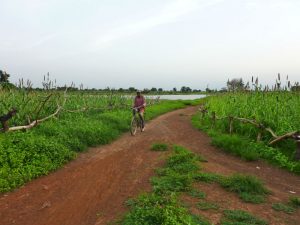Location
Gbedema, Upper East Region, Ghana
Community Description
Gbedema is a rural village comprised of 7 sections containing approximately 5,000 people in the Upper East region of Ghana. It is made up mostly of people from the Builsa ethnic group, who speak Buli, many of whom hold traditional beliefs.
 The main source of income is subsistence farming of millet, groundnuts, and maize. The village has electricity, though most homes do not. Water is drawn from boreholes or wells scattered around. There are two clinics that serve the people of Gbedema.
The main source of income is subsistence farming of millet, groundnuts, and maize. The village has electricity, though most homes do not. Water is drawn from boreholes or wells scattered around. There are two clinics that serve the people of Gbedema.
Gbedema Central has one primary school and one junior high school which are located close to one another and near the village center just off the main road. Gbedema Junior High School serves approximately 200 students, with a teaching staff of 10 teachers.
Currently, the school lacks a latrine facility so students either use the toilets at the primary school, the public latrine, or go to the bush where they often openly defecate.
Project Description
This project is to build a latrine for the school. It will have three compartments, one each to serve girls, boys and teachers.
The structure will be approximately 12 ft x 7 ft, with a height of 8 ft. A rectangular pit will be dug, about 4.5 m by 6 m. The depth will be 4 m. The pit will be lined with concrete to provide stability during the rainy season.
First, excavation will be done by the students. Then the foundation will be laid by pouring concrete into the bottom of the pit. The construction of the lining will continue with the placement of concrete blocks up the wall of the pit until the top is reached and the last row is laid.
 Next, the concrete squat slabs will be built to cover the pit. The inside slabs will have a keyhole-shaped drop hole and foot pads. Using iron rods and boards, forms will be used to cast the squat hole.
Next, the concrete squat slabs will be built to cover the pit. The inside slabs will have a keyhole-shaped drop hole and foot pads. Using iron rods and boards, forms will be used to cast the squat hole.
The outside slabs will be constructed in the same manner except with wire to be able to hold them and the round vent holes in the slab. The concrete walls will then be built by casting them using a plywood frame.
The walls will then be raised. Design blocks will be used on one wall for each latrine to make a small hole so light can enter.
The roof will be built at a slant for drainage. Wood beams will be placed first to support the zinc sheet. Once the beams are fixed then the sheets will be placed and nailed down. The sheets will overlap properly so as not to leak. The three vents will be placed in the outside slabs. A door will be installed for each toilet, including a lock. Finally, the outside and inside of the latrine will be painted.
Appropriate Projects funds will be used to purchase cement, wood, and roofing materials, and also for the hiring of a carpenter and to pay the fee to transport the materials from town.
The community will contribute the gravel. Since sand is not readily available as a local material, it will be purchased.
Recently the school bought two tapped containers, one to serve as a place to get drinking water and the other as a handwashing station.
Hygiene training, focusing on the connection of open defecation to illness, will be incorporated into lessons and clubs.
Project Impact
This project will directly benefit 210 people in Gbedema.
Peace Corps Volunteer Directing Project
Stephanie Carey
Comments
The construction of adequate facilities for teachers and students, paired with education on the importance of using latrines and proper hygiene, will lead to changed behaviors and a reduction in disease.
Dollar Amount of Project
$550.00
Donations Collected to Date
$550.00
Dollar Amount Needed
$0.00 – This project has now been fully funded through the generosity of Sheryl Lewis, with help from other friends and family of Peace Corps Volunteer Stephanie Carey.
We encourage others to continue to donate using the Donate button below, and we will notify Stephanie of your donation. Additional funds will be used to fund the next project by Stephanie and/or those of other PCVs in the country of service.
![]() This project has been finished. To read about the conclusion of the project, CLICK HERE.
This project has been finished. To read about the conclusion of the project, CLICK HERE.